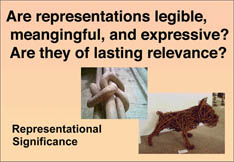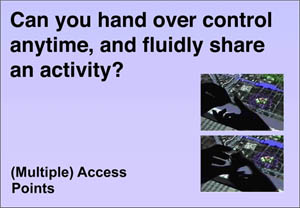E. Hornecker. Creative Idea Exploration within the Structure of a Guiding Framework: The Card Brainstorming Game. Proc. of TEI'10. ACM. 8 pages pdf
Introduction and Motivation
How can we make conceptual frameworks useful and productive for tangibles system design? Usually they are descriptive, explanatory and rhetorical - can we make them be generative?Frameworks tend to be
abstract, systematic, and theory-based. This is hard to reconcile with
creative design, and can feel heavyweight and tedious. Talking with
designers, the following goals for reworking my CHI'06 framework
emerged:
- theory as inspiration, not as straightjacket or as a list of things
to tick off
- supporting freedom of creative process
- don't require people to read 10 pages of conceptual discussion and
theory...
- quickly accessible for students or design practicioners, so they can
start working immediately
- but nevertheless make use of the framework's central notions and
ideals
The aim thus has been to
adapt the framework so as to support design ideation (or discussion of
potential evaluation criteria for a given project). The approach is
influenced by the notion of 'design games' I knew from
Participatory Design (which is actually adapted from the work of the
Architect Habraken as I learned from Mark Gross!)
The framework has been
translated into a set of cards, which each depict one of the
framework's 'provocative questions' along with images. These are used
in a brainstorming exercise with a 'game' format. Different from most
creative brainstorming techniques, the triggers are not random, but
come from the framework. Different from design guidelines and
checklists, there are no lists to go through, no right and wrong
answers, only 'things to think about'. The cards randomize the order in
which the issues are talked about, but allow the team to develop their
own structure.
The cards can be used for
- design ideation
- generating ideas for analysis and evaluation themes
- or to reframe and rethink an evaluation analysis
It is not a full-blown
design method, it's a tool to be used at a particular point in time,
just like other brainstorming methods.
I have decided to publish
the cards and the 'brainstorming game' after collating enough
experience with it to know that the content of the cards has stabilized
and that I can tell enough about the value of the exercise. Even though
this still is very much 'work in progress' (in how to best employ
them), it is probably more important to make the cards accessible for
others.
The Cards: Instructions
Download the cards here. (4 MB)(Thanks to Elisabeth Eichhorn, Designer from Berlin/Potsdam, this is now a fabulously nicely designed version of the cards!)
Print them out one-sided, if
feasible on thick paper, and cut them into separate cards using a
guillotine (or scissors).
For a group of up to 4
people doing a brainstorming session, one set of cards will be enough.
For larger groups, you may want to print two sets.
There are 26 cards. Each
card has 1 or 2 provocatice/sensitizing question on it, plus 1-2
pictures which illustrate these in an evocative way. In addition the
concept from the original framework that the question belongs to is
given in small print (this might be something to get rid off in a
future version).
The cards are furthermore
colour-coded according to the framework themes, but in working with
them, you don't need to know about themes. In practice the colours have
proven useful to devise 'game rules' and they also make it easier to
identify a card amongst the many others on the table.
Using the Cards for Brainstorming - the 'Game' Process and Rules
You can read about my experiences in employing the cards over 10 brainstorming sessions on a variety of projects that were in diverse stages of the design process (from very early and fuzzy, following initial problem analysis and with core goals being decided, up to post-hoc analysis sessions aimed at revisiting and restructuring insights and data) in my TEI 2010 paper.From my experience, a
session can take between one and two hours - any longer becomes
exhausting.
My conclusion from these 10
sessions is further that it works out better if you already have an
inital undertanding of your problem space and maybe have decided on
some core aims of a project. Besides of in design ideation it can also
be used in analysing a system (or your evaluation of it), but it will
be more satisfying if this is not the end of it (e.g. it can give you
ideas for themes for your data analysis or a user study).
I have described an initial
set of rules in the TEI'10 paper, but these are not set in stone.
To start: mix the
cards and distribute them so everyone has 'a hand'.
Core rules and process:
Take turns
- Pick a card from your hand that you think is relevant (or that you think is irrelevant) and explain why.
- The group HAS TO AGREE on
this (the discussion outcome might be other than the initial
suggestion) - negotiating and discussing why or why not it might be
relevant and what ideas it gives you is the main point of the
exercise!
Seemingly 'irrelevant'
cards can sometimes inspire a vivid discussion and new ideas, so give
yourself freedom to think outside the box and to ask 'what-if'
questions. Be playful in disagreeing with each other ;-)
It is also important to
remember that you have freedom to interpret the cards as it fits
your project or to decide that you should do the opposite of what a
card suggests. The cards are merely things to think about, they are not
guidelines or rules.
- Once the group has agreed,
the card is placed on the table according to the outcome (what
works well is to spread relevant cards out, kind of clustering them,
and to move irrelevant cards off to the side).
Usually there is also a cluster of half-relevant cards, which are
deemed relevant, but somehow are not interesting or don't fully apply.
This is OK as well.
- The next person having
their turn has to pick a new card from their own hand.
What has worked well as a (soft) game rule for this is to require picking a different colour or to argue for a different decision regarding relevance/ irrelevance (referring to how the previous card initially was played out). The main aim of this is simply to prevent groups from getting into a routine of 'this is irrelevant, this is irrelevant' and to make them move between the themes of the original framework.
In my experience this last
rule should be only employed softly, as sometimes groups are adament on
following a line of thought. As long as the flow of ideas is good, it
is effective brainstorming. What the rules are good for is that once
this momentum is gone, the group has a structure to return to, and they
also give groups something to start with. They do serve to pace the
brainstorming a bit, and remind people to move on and not to get stuck
at one side-issue.
Invitation - Use the cards and Experiment / Open Research Questions
As indicated above, I don't see this as a design method, rather as a tool to be used at appropriate time during a design process. There is plenty of space for experimentation, and the game 'rules' described above are not necessarily the only possible ones.I am interested in experience reports about using the cards, and experiences from adapting it. Please email me in this case, or talk to me if you get to meet me.
At TEI there were a couple
of questions/suggestions:
- can the cards be mixed with ethnographic data so that field data is
brought into the brainstorming process?
- can we collect experiences somewhere online in a shared space?
- are there other metaphors for card games (e.g. Tarot) that could lead
to rules and that could shape attitudes?
- could cards be tagged to trigger videos or websites of reference
projects?
- how can we figure out whether using the cards actually makes a
difference? (very tricky question... evaluating design methods is
extremely hard as there are so many parameters that are
uncontrollable...)
- could the cards be used to structure a field study and to collect
field data (find stuff that relates to one of the cards)???
....


